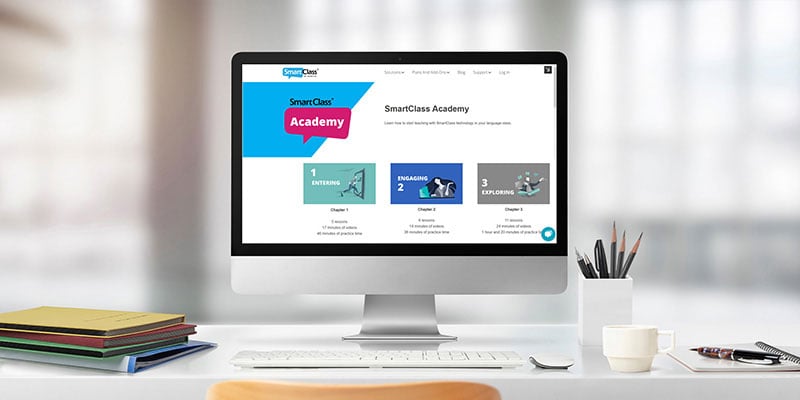ESL speaking activities
I want to start out being brutally honest: when I first started teaching German and ESL, I was focused on surviving, not on my students' speaking ability.
I would even go as far as to say that I failed my students, especially when it came to their language production. I can say this without feeling terrible now because I didn’t let that stop me. I didn’t sit back and enjoy the fact that my students could write and fill-in-blanks and scored highly on standardized tests. I had higher expectations for them, but that meant I had to have those expectations for myself as well.
Let me share with you how I got to the point of “I am not doing enough” and how I overcame my obstacles of getting my students to speak, be confident with their language production, and love the language they were learning.
Sections of the post
- The obstacles I encountered when I started as a language teacher.
- My biggest challenge: getting my students to talk.
- Why is it so important for me to motivate my students to speak?
- ESL speaking activities that worked
- ESL speaking activities: different examples
- Conclusion
1. The obstacles I encountered when I started as a language teacher
A lot of work to create my curriculum
Starting with a curriculum from zero seemed fun, gave me a lot of freedom, and gave me a chance to focus on what I truly believed was important in language learning. But I definitely underestimated the amount of work and research this would include.

The lack of knowledge of my students
None of my students had any prior knowledge of the language they wanted to learn.
So, I couldn’t dive in with discussions, projects, and conversations. I focused on words, phrases, basic grammar, and building their vocabulary, hoping we could soon get to all the fun activities I had planned and imagined.
The lack of materials and equipment
The school where I worked didn’t have a language lab or any material for language learners. Languages weren’t a priority either. All they cared about was for the students to earn the necessary language credit, and focus on their majors or sports.
Very little student participation
I am not a psychologist, but I would say 95% of my students were introverts. No one volunteered in class. No one wanted to say anything, even though I encouraged them to.
I even brought candy to hand out to everyone who would raise their hand, volunteer to repeat a word, or read a sentence out loud.
It also didn’t matter when I told them oral participation was part of their final grade.
Somehow there was a (language) barrier and fear/embarrassment that they just couldn’t overcome, and I didn’t know how to help them.
Big class sizes
My classes were pretty big. I had 30+ students in each section. Even if those students had been more outgoing and willing to make mistakes, there wouldn’t have been enough hours in the day to have a conversation with them all, or help each individual with their pronunciation, or give everyone valuable feedback. There wasn't time to be the native speaker example they could model after.
No materials with speaking activities
- All the textbooks and materials I found were based on grammar, topics, or themes.
- A few textbooks had an online component or a CD/audio so students could do some listening activities at home or in class, but barely any had speaking activities.
- I found some ideas for having students make voice recordings where they spoke about a topic, but with all the time I spent on prepping and grading already, it seemed overwhelming and way too time-consuming to listen to all of those as well.
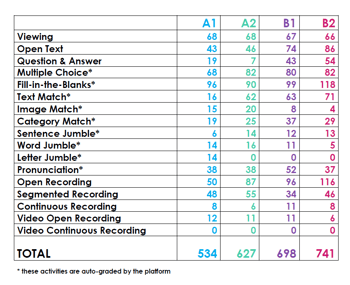
My biggest challenge: Getting my students to speak!
It didn’t take long for me to realize that I was doing something wrong.
However, I first reached the point of “I am doing too much.” I spent hours and hours at night and on the weekend grading, researching activity ideas and materials, prepping games, and making copies. But very little changed in the classroom. It was frustrating. I wanted to give up. Why put in all that work when there aren’t any improvements?
For a while, I just went with what I had and took a mental health break for myself. I needed to do less and rethink my strategy.
My students still liked my class during that time. I could tell. They smiled. They told me they loved my class. They even went so far as to tell me that they had never had a better teacher.
But when it came to making themselves vulnerable and saying something in front of the rest of the class, they shut down.
In college, I had heard about the importance of speaking activities for foreign language learning, but somehow, we never really talked about the HOW or WHAT.
Heck, we never even really had to do any speaking activities ourselves. I had one “Spoken English” class where we learned all about English sound formation, the role of the lips and tongue for speech production, and so forth.
Otherwise, it was up to you how much you participated in your classes. There were a few mandatory presentations, but most of my English professors weren’t natives. They were highly intelligent, and knew their subject matter, but didn’t have the best accents or pronunciation themselves.
We didn’t have a language lab at our university either. And none of our final exams ever included a speaking or even listening part. It was all about writing papers or multiple-choice tests.
So fast forward. After a few weeks of taking a break from “doing too much,” I asked myself, "Am I doing it all wrong? Am I not doing enough?" So what do we do if we have fundamental (or totally random) questions? Right, we go online!
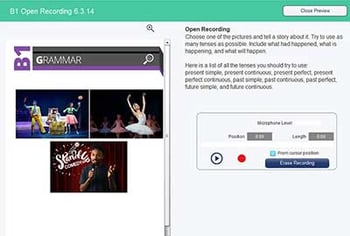
Why is it so important to motivate my students to speak?
The goal of learning (and teaching) a language is to make students able to communicate in that language.
Think about how you find out if someone knows a language. You don’t ask, “Do you read English?” or “Do you write English?” You ask, “Do you SPEAK English?”
English is becoming THE universal language. If you're able to speak English, you will likely find someone else, no matter where in the world you are, who also speaks English, opening up a world of opportunities and possibilities for you.
Speaking is essential to human communication. Think about your day and try to estimate how much time you spend speaking, listening, writing, and reading. Most of us spend way more time on speaking and listening than writing and reading so why are most ESL activities centered around writing and reading?
We all have easily learned at least one language through exposure from the moment we were born. It’s natural to learn languages through listening, processing, and then imitating those speech sounds. We weren’t writing or reading before we spoke our first words. And that’s how we should approach foreign language learning as well.
ESL speaking activities that work!
I will share my best strategies here, but none of these would have been successful without the modern language lab software, SmartClass, a teacher friend of mine told me about. There will be many more posts about what this amazing and affordable software can do, so I will focus on the speaking solution here today.
Here are my tried and true tips for ESL speaking activities (or any language really)
1. It’s okay to make mistakes
It sounds simple, but besides the general classroom behavior rules you have established, there should be something about speaking. I told my students about my own struggles learning foreign languages. I opened up about myself and gave them the okay to correct me whenever I made a mistake. Because I did. And still do. And as soon as one of them was brave enough to call me out, everything changed. They made it a game. It became a motivation to listen, to pay attention. And because I laughed and showed how vulnerable I was, they were okay with being vulnerable as well.

2. Overcome cultural barriers
I took time to sit down with every student and learn more about them: their culture, their background, their hopes, and their dreams. And I was surprised to learn that for many, speaking in class is a new concept. Many came from backgrounds where they sit and observe, take notes, and study. Not participate. So, we had a big discussion about how this is different in our classroom setting.
3. Exposure
Speak English as much as you can and label everything. We took an entire session where students looked up words to label everything in the classroom. Students also started taking turns writing down important phrases, and grammar charts on posters that we hung up.
4. Real-life situations and appropriate level
My first-year students became my guinea pigs, and we learned together. I learned that many of my conversation activities weren’t as good as I thought. They just gave students a chance to say a few words or answer with yes/no. They were often too hard, and students would fall back into their native language and continue there. The same is true with some activities that were too easy. Students finished quickly and went back to their native language to chat.
5. Timing is everything
I used to think it was great to start the lesson with a warm-up speaking activity, but I quickly came to learn that often those were just continuations of the talks they had in the hallway or classroom prior to the start of our class. So I found some calmer warm-up activities and added the speaking activities back in later. It was a huge difference. The students were so much more focused on the topics and enjoyed the chance to work with a partner or group.
6. Give them a chance to practice pronunciation
This was impossible. I always tried to model the vocabulary words, had students repeat them, and walked around during speaking activities to assist whenever possible. But I couldn’t be everywhere all the time. That changed with the turnkey activities. All my problems were solved at once!
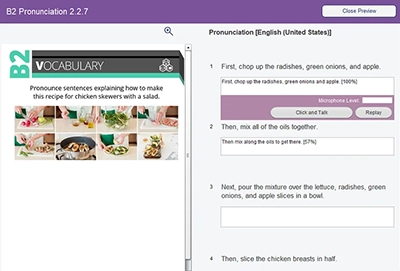
ESL speaking activities: different examples
This software, SmartClass, and its complete ESL curriculum were the answer to everything!
The topics were relevant, with a wide variety of activities for each section/chapter.
There was enough to pick and choose from, and I was able to add my own activities within minutes as well. Multiple choice, fill-in-the-blanks, category match, sentence jumble, word jumble, fill-in-the-chart, open text, question-answer, image match, open recording, videos, segmented recordings, true-false….it was all right there.
But, as promised, here are the ESL speaking activities that worked.
Pronunciation
Flashcards are a great way to practice vocabulary words. With this software, not only can students practice the words, but every word is also presented in a sentence that students can hear (in a native voice as often as they want) and then record themselves saying it.
Thanks to artificial intelligence, students get instant feedback as the computer types what it hears and gives students a percentage of how many words in the sentence were correct. They can then compare the speech-to-text sentence with the original and try again. I could even enter the sentence or word in the student’s native language to make the flashcards more of a memory game. But otherwise, there is a picture explaining every word!
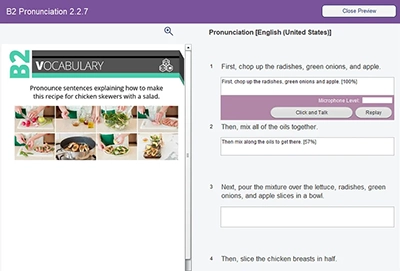
I can’t tell you how this changed everything for me! But most importantly, it changed everything for my students. They got so much more comfortable with the language. They could practice as much as they wanted with a native speaker model. They became confident and excited about the class.
Individual ESL Speaking Activities
Before, it was impossible to have individual speaking activities because there was no way I could have a conversation with every student in those 60-minute periods.
But I really learned how important it was, just like the pronunciation activities, for students to be able to practice without judgment and fear or embarrassment.
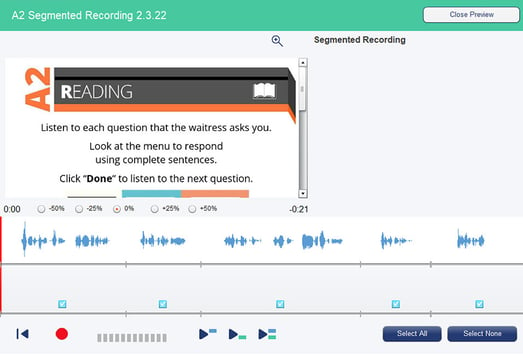
I loved that I could listen to the individual recordings at home (and because I didn’t have to grade anything else, I had plenty of time to listen and give feedback!) It gave me a chance to give students honest feedback. What I especially like is the fact that I can record feedback. So, if a student struggles with a certain word or concept, I can just record how it’s done correctly. And I don’t need to type anything up (even though you can, obviously, do that as well.)

There are so many different ESL speaking activities in this program. I never really thought about using videos or recordings as a stimulus to get students talking. I only used some questions or gave them a situation. But this was a game-changer. The students have a chance to see or listen to something that gives them specific ideas. They can rely on that, respond, and practice real-life situations in real time with segmented recordings! But they also have the chance to listen to themselves, correct, delete, and re-record, because it’s still practice and I want them to be successful.
The combination of images, questions, audio tracks, or videos with the recording part is amazing!
ESL Speaking Activities for Partners
Thanks to all the individual practice, my students were so much more ready to work with partners. They didn’t fall back into their native language anymore. They really tried. And thanks to the LIVE component of the software, I had the option of listening in on the pairs and their conversation if I wanted to. I was also able to record it to listen to later or go over with the students themselves.
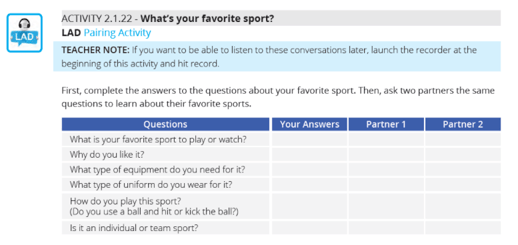
ESL Activities for Groups or the Whole Class
I was worried about the whole class or group activities. Those were the ones where I felt I lost the most control over the class. Students would fall back into their native language, or no one would speak at all. I will be repeating myself, but this wasn’t the case anymore with LTE and its activities. They have wonderful small group activities and templates for all kinds of games that you can play as a whole class or in small groups. All of them are focused on speaking and teamwork and are geared at the students' exact level.
Conclusion
So, if you find yourself in a similar situation, if you also feel like you are doing too much or not enough or not the right thing, if you want to encourage your students to speak, if you want them to be successful, confident, fluent, stronger native-like speakers, and so much more, then I can only recommend trying these different types of speaking activities.
You can try the pronunciation feature in free activities in many different languages. That alone could be a great game, warm-up, or a simple speaking activity to break things up. It’s a lot of fun to see the students try and succeed!
